Numerology of the Tarot System
by Rudolf Bernoulli
presented at the second Eranos Lectures in 1934
translated by Clark Kee
The goal of my first lecture was to offer some samples from the field of symbolism that express themselves in the language of mathematics, in geometry and the concept of numbers. Along with that it could scarcely be my intention to pull together the lines linking the individual examples. Such an assignment presents itself now in the second lecture, however. I must assume that the individual elements and fundamental views of the first lecture are known.
A numeric sequence exists that in its formulation and in its relationship to meaningful images holds a particularly intensive symbolic value: It’s the way the numeric sequence has been embodied in the long since secularized Tarot system. It has been passed down to us in the 22 trump cards of the card game that is still played today in Catholic countries under the corrupted name “Tarok.” In its first verifiable appearance in Europe this game was called “Naibis,” “Naaba,” “Naipes.” That may suggest that a deeper import lay, or originally lay in this kids’ game, as the word goes back to the concept of Naabi, which M. Buber translated as “the Prophet” and made accessible for us. So a system of prophetic images that one can certainly also “play” with.
But not just the name indicates a deeper meaning for these picture cards. The images themselves with which they are decorated show here and there echoes of types reaching back deep into antiquity.
There are two cultural milieus that present a not-coincidental relationship with the images in our game: Egypt and India. We will not speak of completely uncontrollable rumors that would happily dress up modern secretiveness as Egyptian mysteries. (I’m reminded of the so-called Egyptian masons at the time of the French revolution and of their offshoots that still scrape out a quirky existence today in semi-educated circles.) I simply point out the fact that, for example, the 18 card shows two dogs lying across from each other in front of two massive towers, while the exact same presentation can be found on an Egyptian card preserved with other similar cards in the museum of antiquities in Turin.1 I’ll mention in passing that Court de Gebelin the well-read scholar and historian with all-encompassing interests pointed out similar connections in his work Le monde primitif, Paris 1776. The interpretation that the 42 Books of Thoth that Clement of Alexandria mentions in the 6th book of his Stromata have a close relationship to our card system will be explored further.
The Indian parallel is perhaps more striking, in that a card game – the so-called “Caturanga-Game,” which is a game of four categories can still be found today in India. These 4 series are identified with 8 attributes of the god Vishnu. From these only 4 appear in the European Tarok game: scepter or club, sword, disc or coin, and finally conch-shell horn that in the European version has been reconfigured as a drinking apparatus. In the Indian as in the European game there is in addition a fifth series, the trumps (garbled from the Italian “trionfi’), which appear with symbolic images as embellishments of the numbers 1 - 21 and 0. This last card carries the name “Le Mat” in French, derived from the Sanskrit word “matto,” which means “fool.”
The count 21+1 is not accidental. Clearly there are 3 rows of 7 and a surplus unity to see [lit. sense]. According to tradition these 3 rows are identified as three paths that go through the whole system so as to imply a 4th path with the last symbol. Doubling 21 leads to 42 and opens a perspective on the 42 Books of Thoth introduced above. Each number and and its image would then symbolize 2 Books of Thoth. On the 0, which carries the picture of the Fool, none of the Books apply. In fact, the Fool does not need one. It could be that he can’t comprehend it, or that his fool’s wisdom sees deeper than book learning.
But now we’ll place the image and number system of Tarot also in relationship to Kabbalah. The 22 letters of the Hebrew alphabet sometimes find themselves on the 22 picture cards. And therewith we suddenly have a completely other differentiation of these numbers and images. That they are connected to the thought emanations that descend hierarchically from the creative spirit to the last solidification of the world is already present in the concept of the One that divides and increases itself, and eventually in the last card finds its outermost periphery, a circle that incorporates everything.
The 22 Hebrew letters arrange themselves in three categories, and, as the card images appear similarly designated, these as well. Next there are “the three mothers”: the beginning (the 1), the middle (the 13) and the end (the all-encompassing 0). They correspond to the fundamental physical concepts of medieval cosmology: that which flames, flows, and is solid, of which the last is the result of the two others.
Then come, irregularly divided, the 7 doubles, which one easily recognizes as corresponding to the 7 ancient planets, and similarly the 7 principal metals. And finally the 12 singles remain, which do not appear movable like the preceding 7, but rather circumscribe events in a fixed circle in a specific order, the Zodiac with its 12 signs. The first 3 pervade everything, and control it at the same time. The 7 show the continuous journey in the circle of the 12. An image that, with manifold variations, reflects back the fundamental concepts of medieval cosmology, and its offshoots in the speculative alchemy of the 1700s.
But how did we come upon the 3 and 7 and 12? Here we must inject a little geometric excursus that shows how everything develops from mathematical facts, leaving no possibility of coincidence.
The right-triangle, whose sides stand in integral relation to each other appears in the simplest combination having the numbers 3: 4: 5. 3 and 4 are the short sides, 5 the hypotenuse, or, as one can also formulate it: 3 is Osiris (Yang principle), 4 Isis (Ying principle), and 5 their son, Horus. He contains in his number both parents, as 52 = 32 + 42, or 25 = 9 + 16.
From the stepwise addition of the individual side of the triangle emerge the numbers:
3 (the shortest of the short sides by itself)
7 (the sum of the short sides)
12 (the sum of all three sides).
And more: The 3 is contained in all three numbers, so can be designated as a triplet, or as “the mothers.” The 7 is in the second and third numbers, so appearing twice, out of which the name of the “doubles” is derived. The 12 is first encountered only in the third number, and appears only once, from which the name of the “singles.”
With that the apparently coincidental system of the Hebrew alphabet and with it that of the Tarot symbols lead back to the law of the right triangle. In the same way that the letters of the alphabet are placed together in multiple ways [leading to] a new meaning, so also the individual cards of our image and number system. That’s why they are created in this form and not as a book. That this circumstance is used to make them a mere game can’t change anything in the circumstance that it must have originally been more than a game.
Also the name was deformed by the degeneration into a game: originally (and in French still today) the system of images was named Tarot, a unique combination of different words; that makes an appearance if the word Tarot is arranged in a circle:
T
O A
R
There we find that, read right to left, the Hebrew law “Tora,” and in reading left to right continuously turning, the Latin “Rota” arcanely embedded. Law and turning or journey, one could hardly express the idea of our image system better.
The connection to the study of Kabbalah doesn’t just appear in the analogy to the letters of the Hebrew alphabet. Also in the extensive relationship to the thought emanations, in the way the 10 Sephirot present themselves in successively deeper levels of creative powers. These are also marked with 1 to 10. And clearly connections are woven between these and those on the Tarot cards. If we accept, now, that the 10 Sephirot represent the first 10 Tarot cards, then the 11th would represent a turning point, in a sense like the surface of a mirror in which a reflection of the tier of the first 10 appears. Here the phenomenal world begins on which on which the creative forces have an impact. The 12 mirrors the turning point itself in the fact that it’s pictured as “Reversal,” an inverted hanging person is its symbol, while the last card, the Fool, reflects the beginning, the One from the bottom up.
In this way the system of the 22 Tarot cards presents a whole many-sided geometric aspect that suggest that for individual cards a deeper meaning only appears for those who seek to penetrate their geometric facts. Admittedly one is led here completely by feeling. Something can hardly ever be proven. It could be something like that. But it might be something else. What is fixed is the number of each card and the fact that the image personifies the number in living form. Now how do we think about that in detail?
1
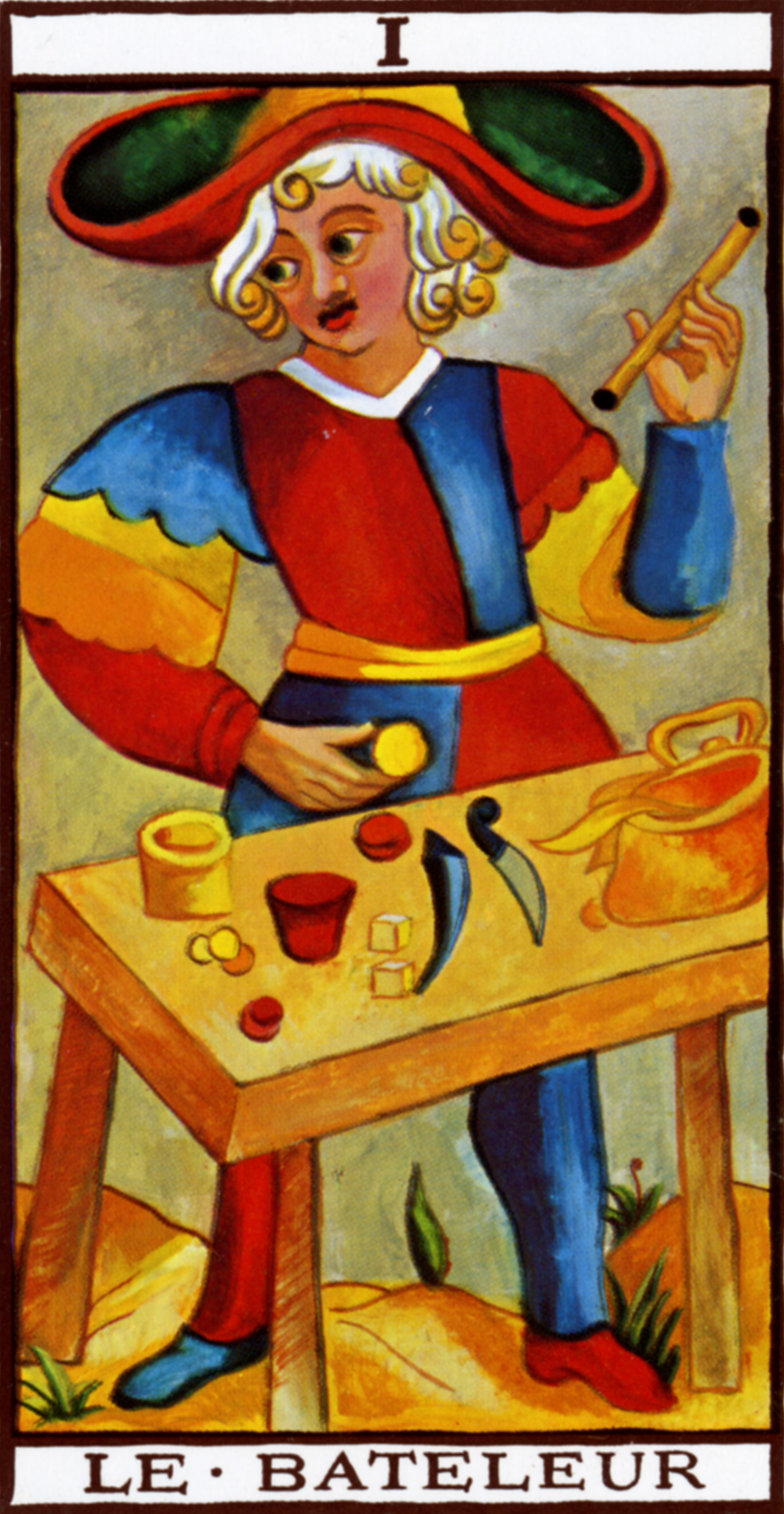
The card with the number 1 shows in the version on which all newer Tarot cards are based, whose date goes back to around 1700, a magician at a fair, with a wand and coins in his hands, cup, knife and more coins on the table. His hat exhibits the form of a lemniscate, which in the shape of a horizontal 8 is used in mathematics as the symbol of infinity. Out of infinity, the unrevealed, this one crossing point jumps out. Through a miracle, from the innumerable the number 1 shoots forward. Lao-tse calls it the most secret occurrence: the revelation of the unrevealed. And it is exactly these portals of revelation that we have before us. From the inconceivable, shapeless the first one is born, out of which everything else develops. And already the building blocks of the universe of possibilities lie before him: the wand as masculine, the cup as feminine, the sword as the union of both, and the coin as neither.
2
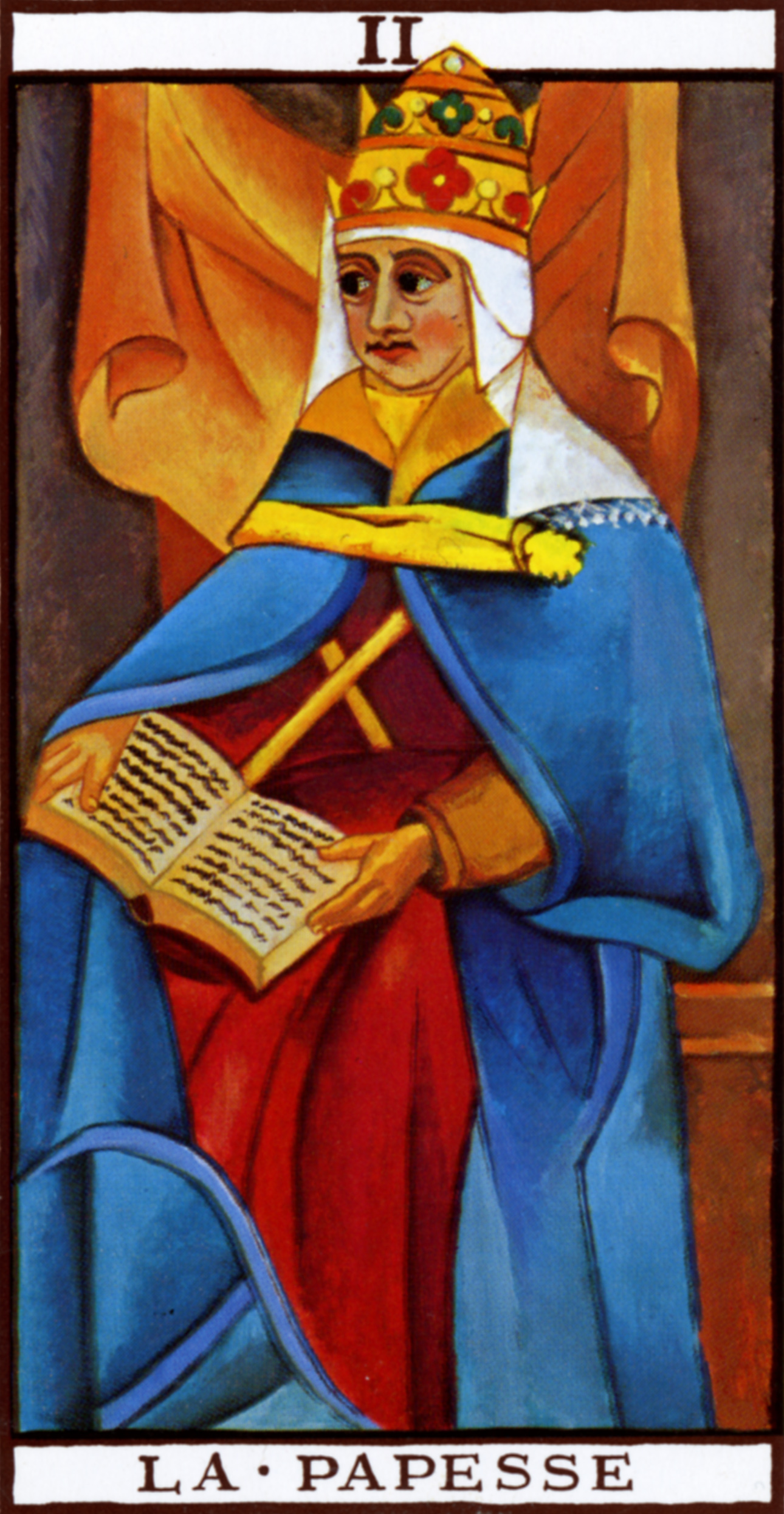
Why is it that the number 2 is set in the picture of the so-called Papess? Initially the name must be traced back to the concept of “Church,” that with its teachings left behind the veil of secrecy. This veil appears in our pictures floating freely. We may assume that it was originally pictured hanging from 2 pillars, which 2 pillars, Jachin and Boaz, were understood to be symbols of 2, the polarity. From the one, the point, emerges the duality, the pull to the left and right. The first emanation, the Man is followed by the second, the Woman, in this form also Sophia, knowledge, or Ekklesia, the church, which is also depicted as an emanation or aeon in gnostic systems.
3
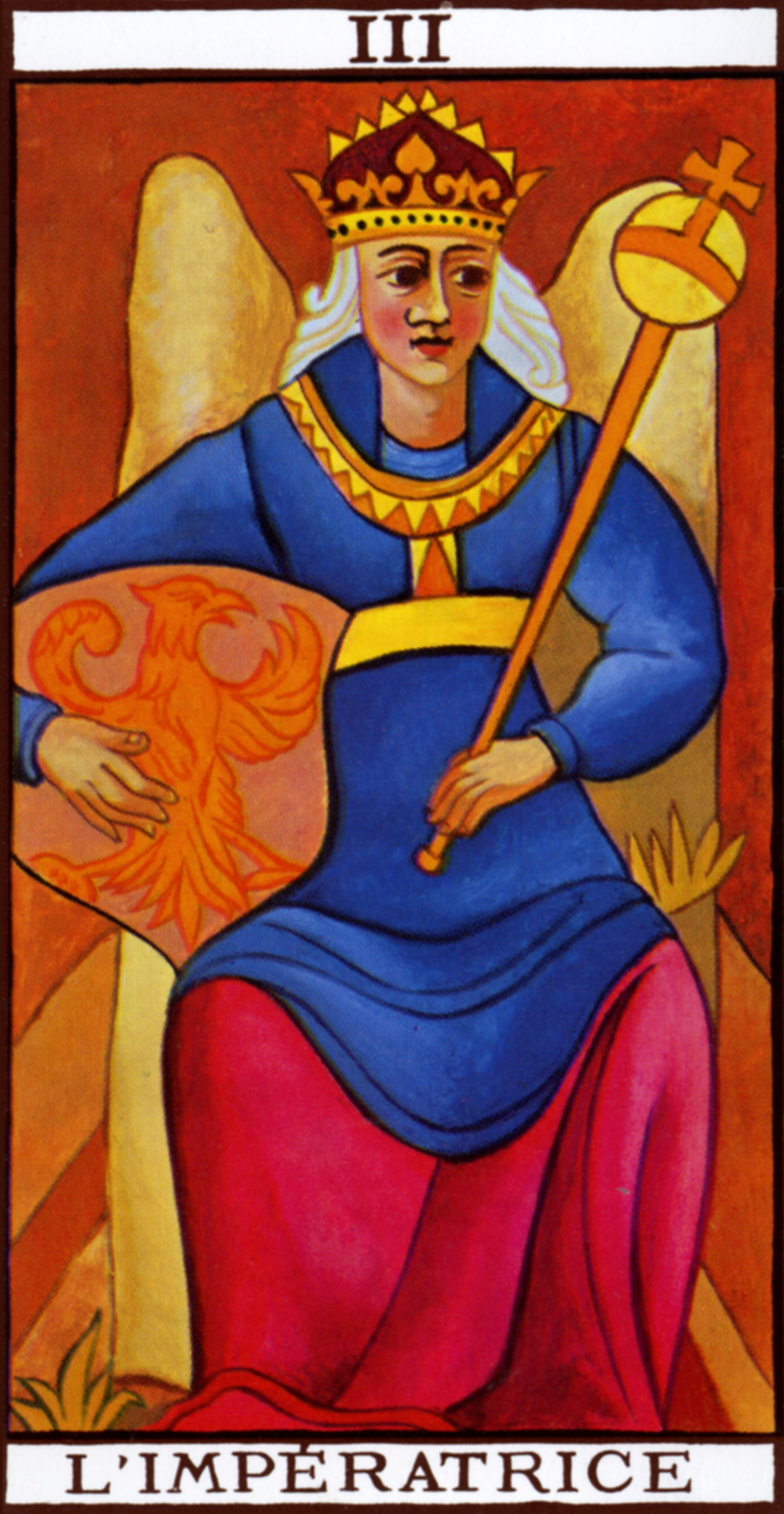
And now the triangle takes form. The trinity appears through the Empress, a figure who unites masculine form with feminine manner. The triangle manifests the spirit, as “heaven,” related to the circle.
4
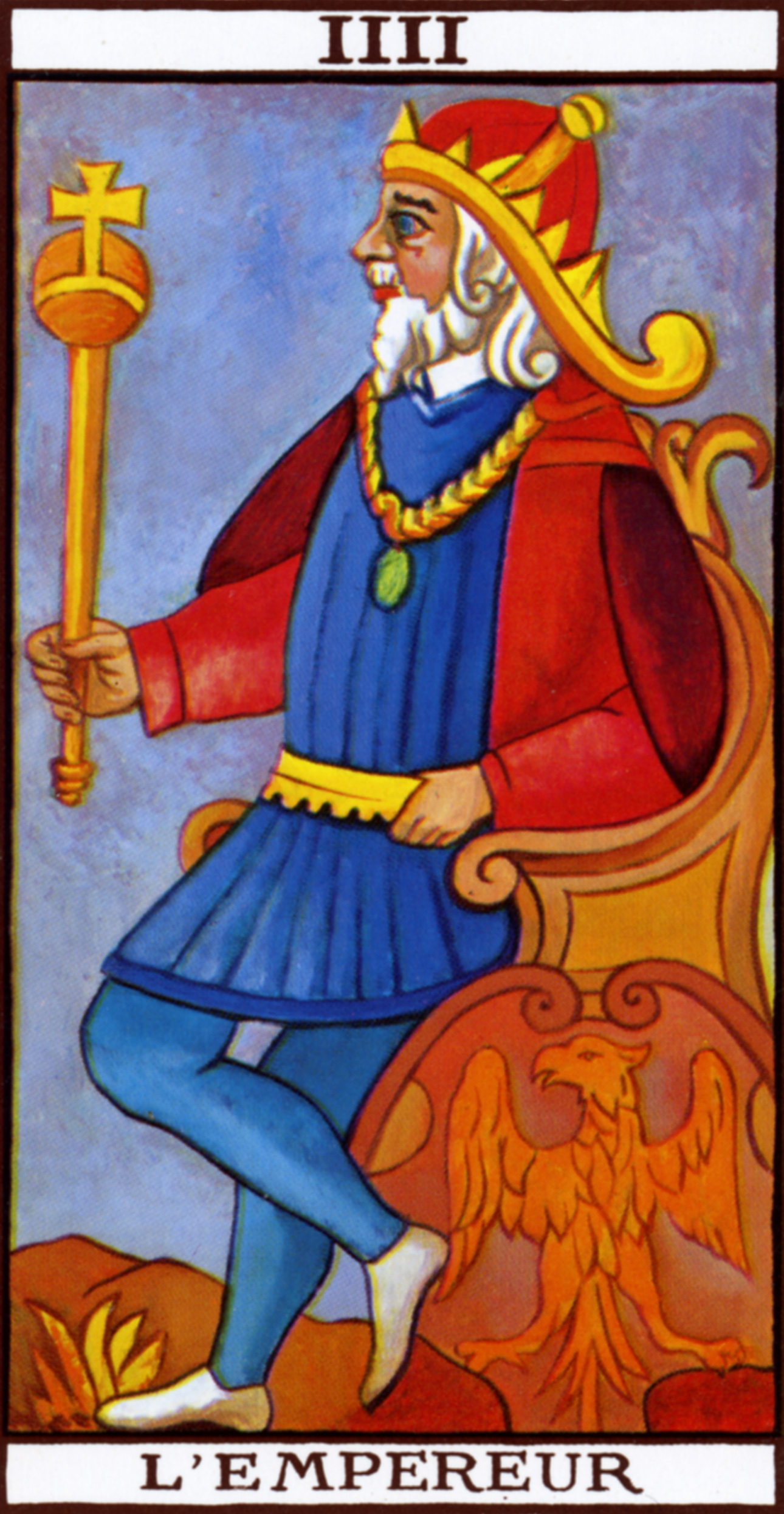
The Emperor refers to the 4 regions of the world, the dimensionality ranging over the 4 points of the compass. With that a distinct evocativeness is given in which lacks a center. In contrast to the triangle, the square can be interpreted as “earth,” or matter in space, which indeed according to the ancient view manifested in 4 states.
5
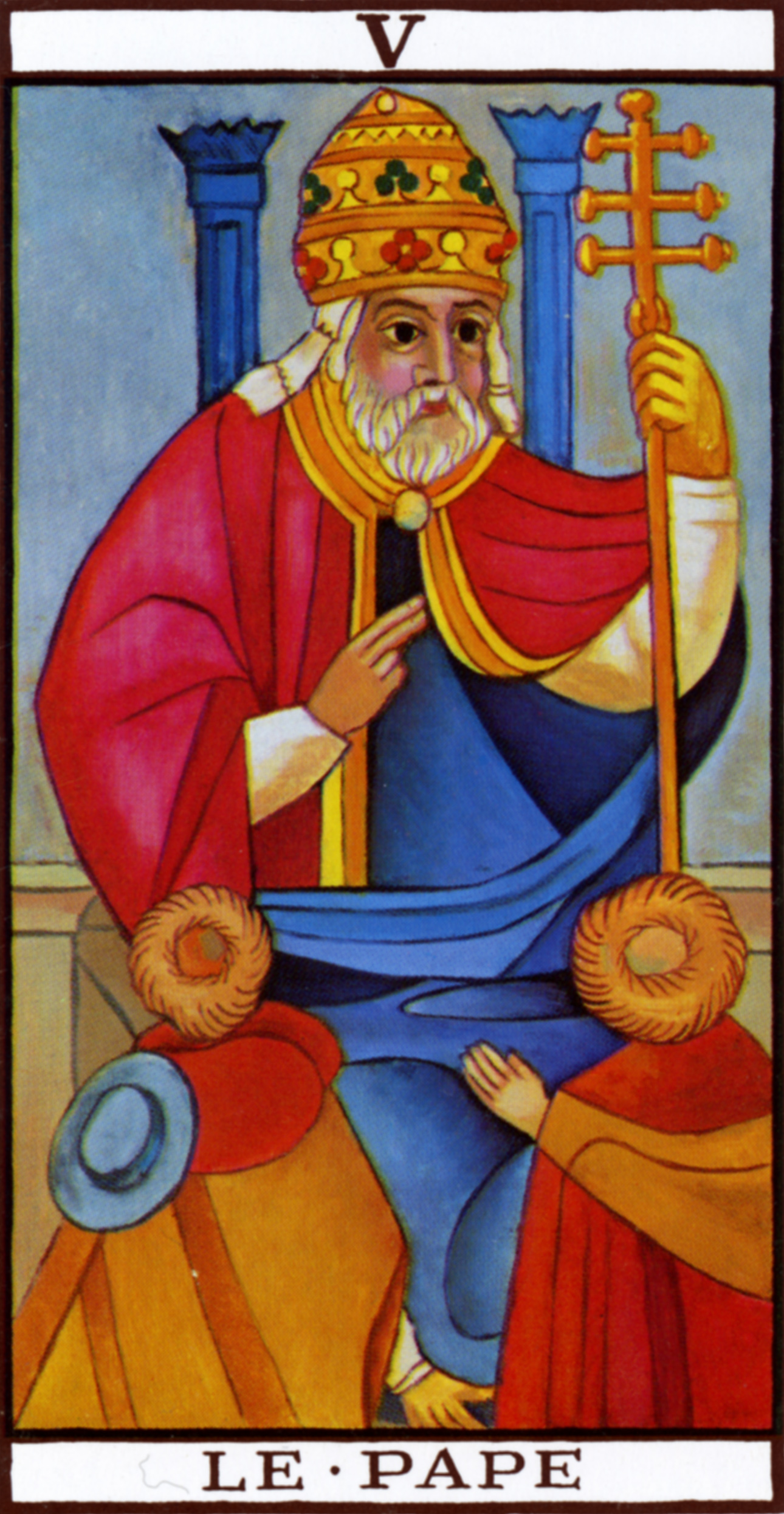
Clearly the figure in the fifth card refers to the second. Here the two pillars are indicated that are missing there. In the foreground the Pope, the head of Christendom, is enthroned. The idea whose existence in principle is depicted in the second card, here is embodied in a person. The human being is assigned the number 5 in most number systems (by Agrippa von Nettesheim, for example). Its symbol is the pentagram, the five-pointed star. Here turned toward the divine, that is to say with the point facing up, and below streaming toward two directions, which are indicated by the two kneeling clergymen. Their differently-colored clothes suggest that they can be thought of as polarities of the opposing possible reactions to doctrine. With them also appears the hint of the geometric figure of two, which further differentiates the arms of the angle pointing in different directions.
6
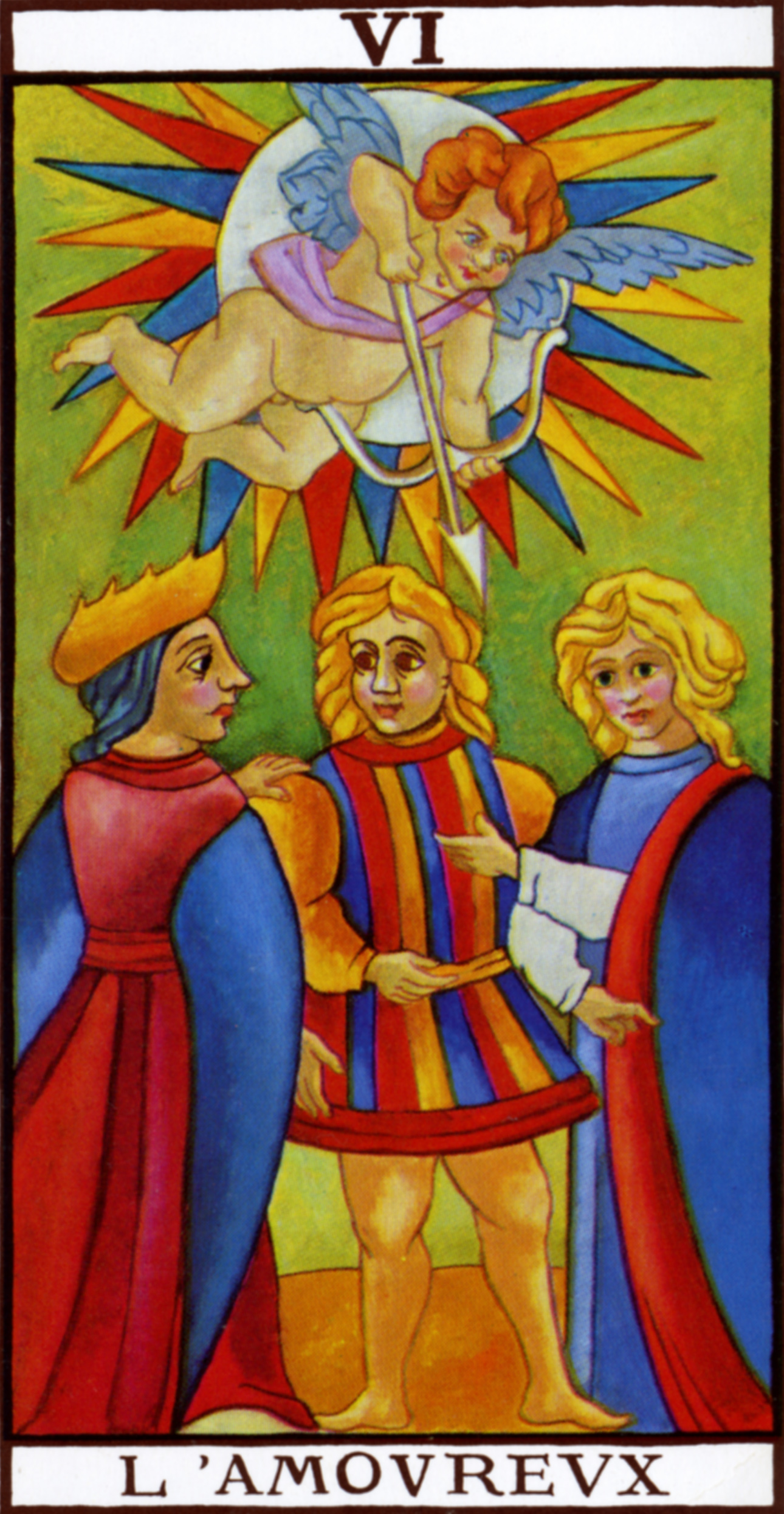
The misleading suggestion that the sixth card presents a lovestruck youth is refuted by the image itself. The youth faces a decision. The arrow has not yet been shot. Both possibilities lie before him: the direction above and below, to the left and the right. This double possibility is indicated by the two intertwined triangles. Nothing is yet decided. But in the aftermath a decision must be made.
7
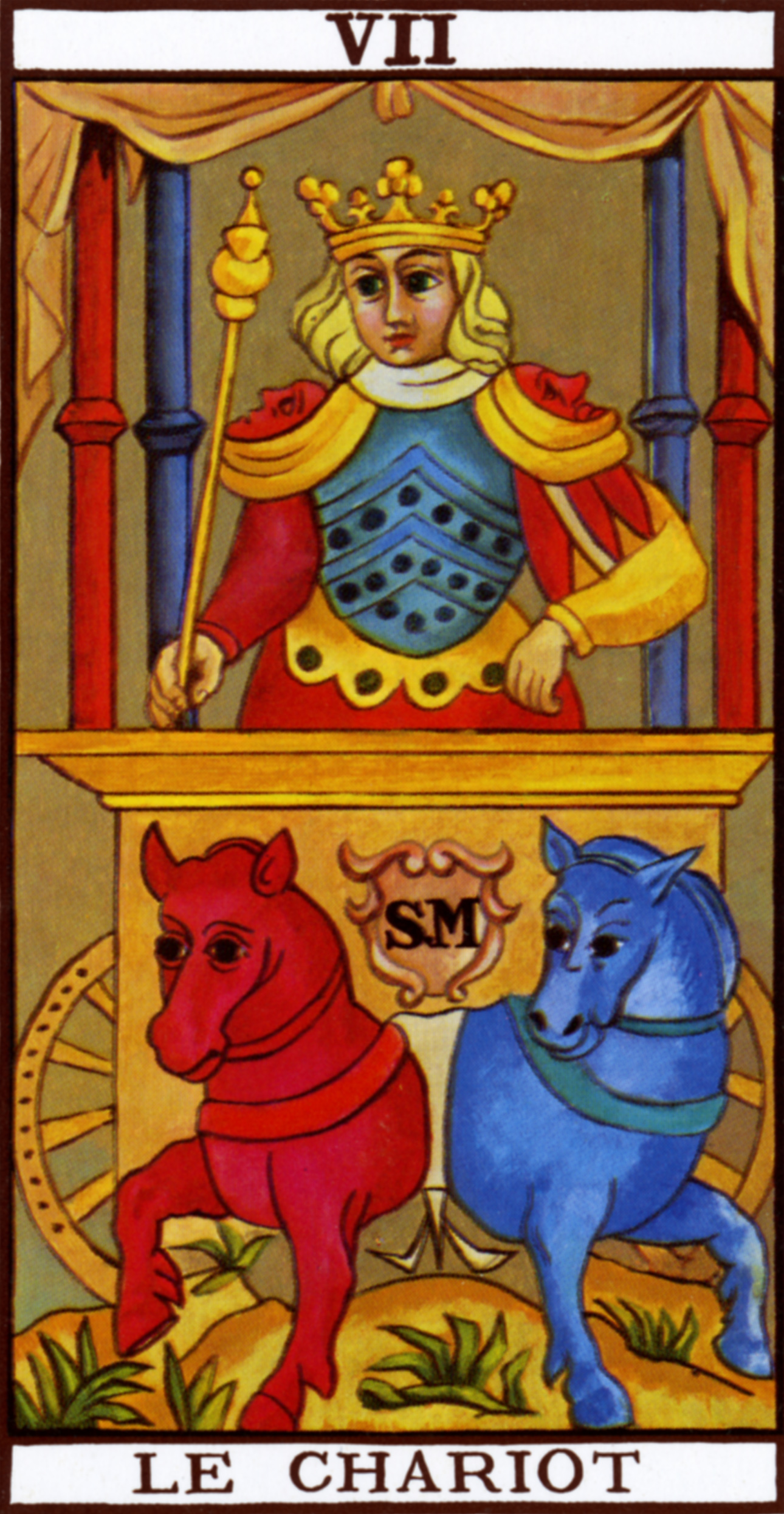
The triangle in a square, the decomposition of the 7 into its components [lit. summands], depicts the spirit enclosed in the body. With it the possibility of an unfolding in space is given. Clearly connections spin from 1 to 4, that at first show a rectangle, and now a 7. It’s the Emperor who is first enthroned in his solitude, then pervades space and animates it through his spirit.
8
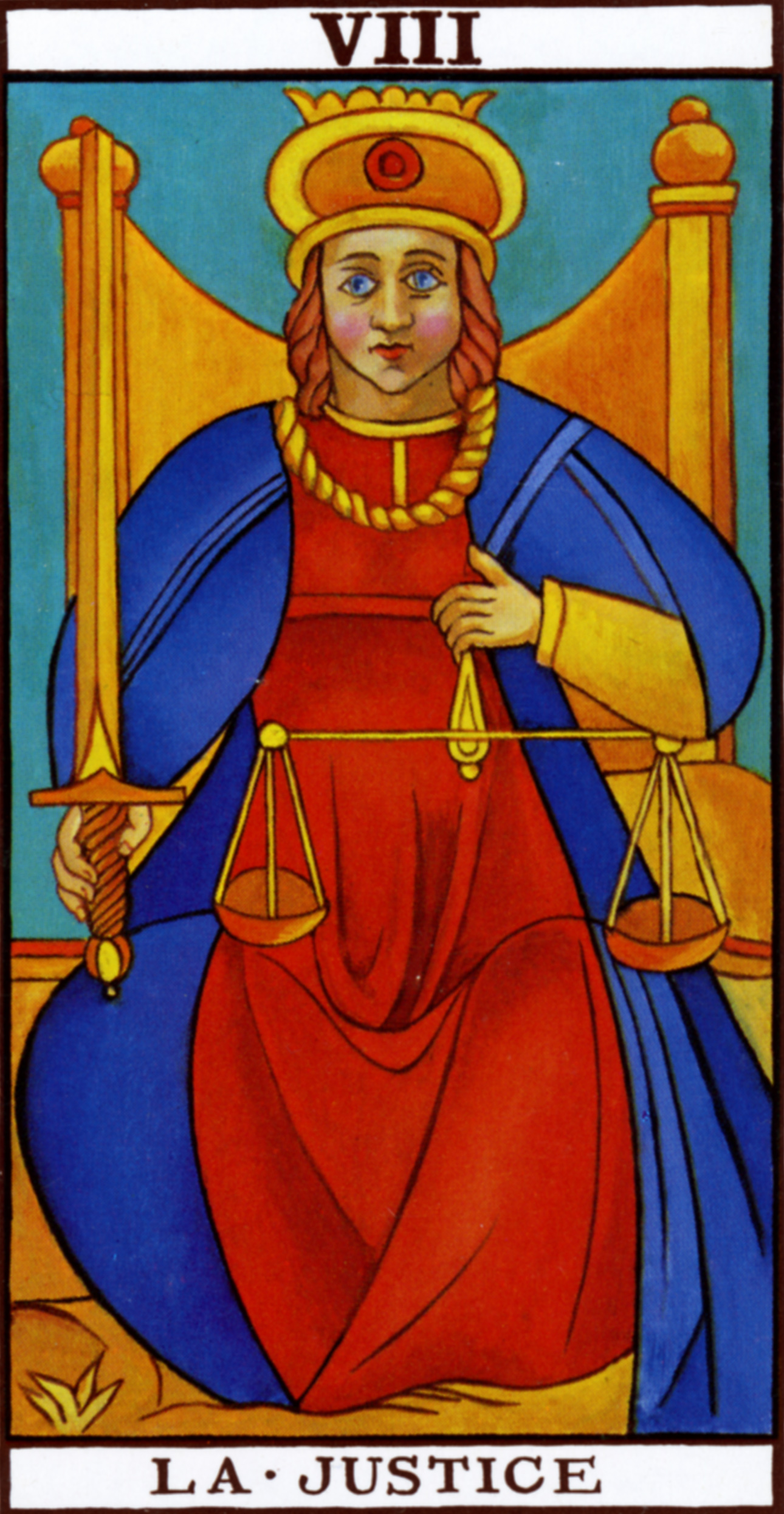
In the same way that the 4 is stretched in opposite directions, so the tension and regular arrangement of the 8 even more so. Two diagonally intertwined squares point to this state of equilibrium, made clear by the symbolic figure, which is clearly made from the Empress holding the scale of justice.
9
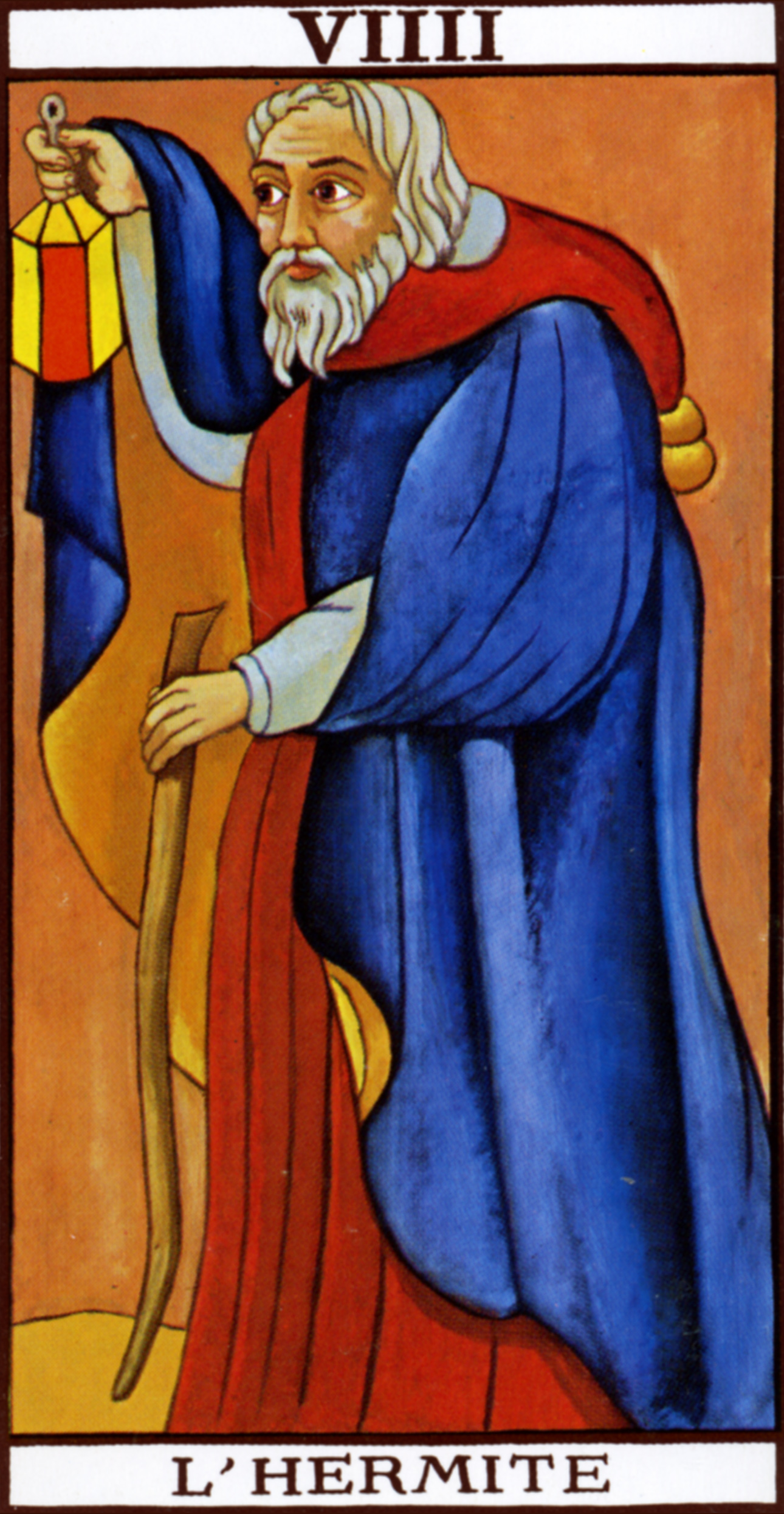
In this, after a space extending equally on all 8 sides, now a light twinkles. It’s the lantern of a hermit. For the first time a center, a marked midpoint, in the world process. The point of unity has now established itself in the middle of a world extending to the eight points of the compass, and illuminates it, even in a restricted circumference. Maybe we can designate it the birth of consciousness, that appears initially alone and unconnected in space.
10
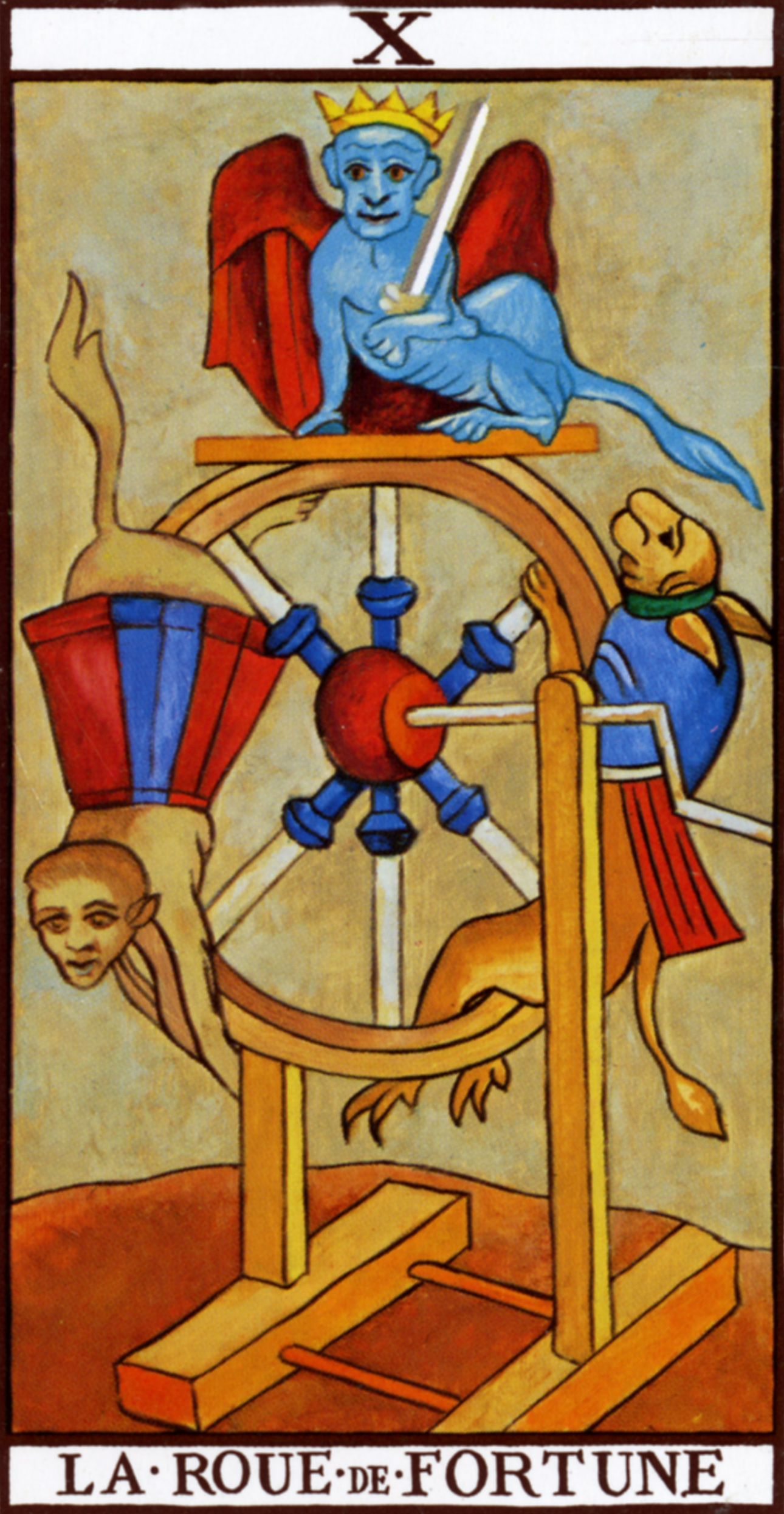
The 10 completes the rows of the Sephirot in the system of Kabbalistic emanations. With that the world was formed. All its possibilities are given. And now it can begin its cycle. Likewise in the Tarot. The wheel turns. It becomes the wheel of destiny or fortune if the human appears intertwined with it. It moves upwards or downwards in the direction initiated by him. The two possibilities (not just as an idea, as in the sixth card where both did not follow through at all) here are embodied and put into practice through the people. The one formed like Anubis aspires to reach up (the point of its pentagram points that way). The other marked as the darker Typhon, pushes down. Because the two pentagrams are not aligned, they do not tend toward stasis. Through their individual movements they achieve a circular motion. Certainly it appears lost motion, in the same way that the course of the world is a meaningless going-around-in-a-circle, if we fail to give it meaning. The Indian concept of Samsara, the eternal rolling cycle of the world, seems to me to best depict this pattern. But the Sphinx, who encompasses the meaning of the whole, is enthroned above, but only makes it known to those who force him.
11
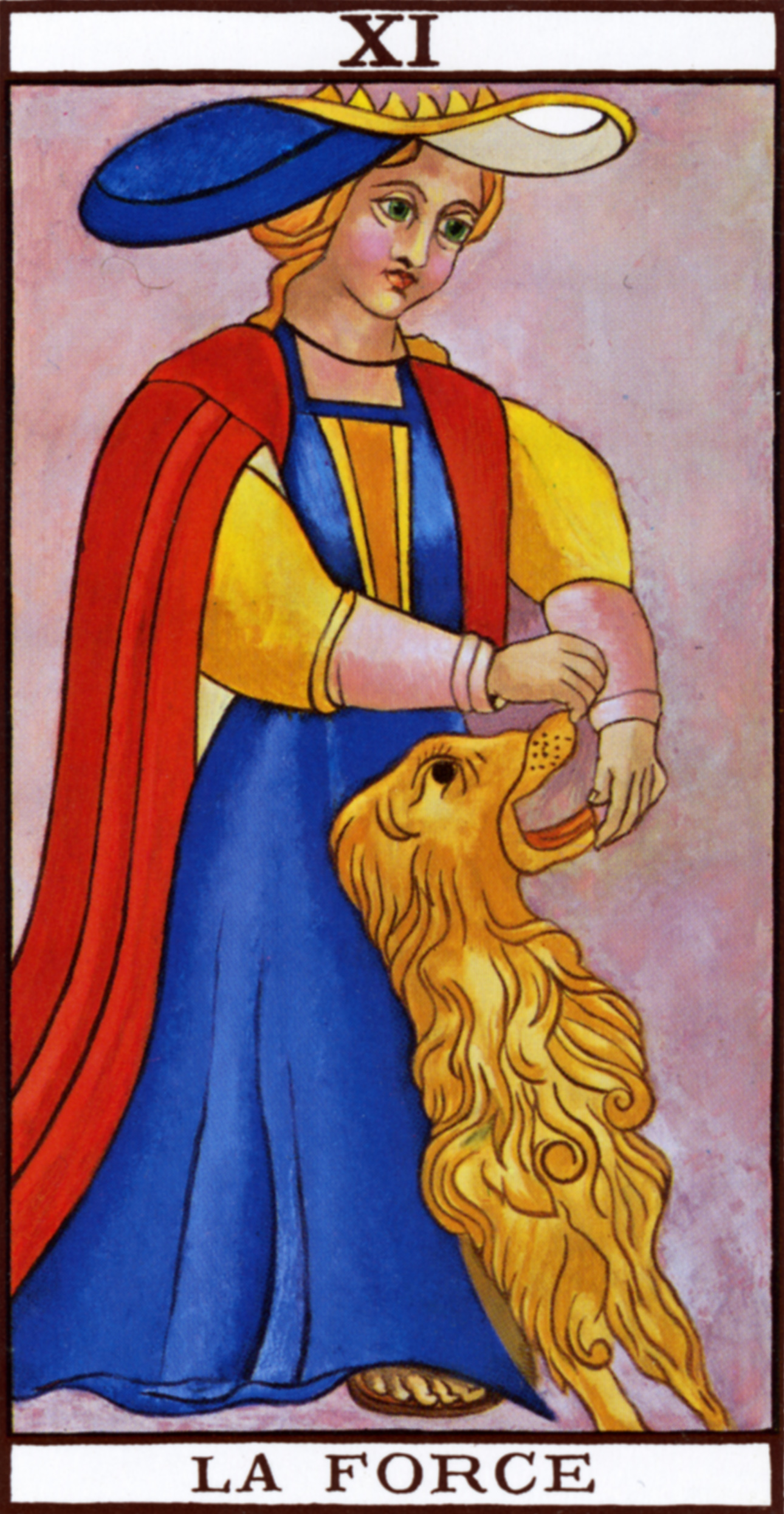
If the 10 appears as movement without a center, in the 11 we find a pole at rest, the point that Archimedes postulates, in order to take the world off its hinges. It’s the entrypoint to the present. As in the picture that embodies the 1, it is also signified here by a point of intersection with the lemniscate, that adorns the hat of the lion tamer. And now the two pentagrams, the incarnation of good and evil, angel and beast, that just chased each other in the wheel, placed in fierce struggle set against each other, with one aspiring to what’s above, the other like Antaeus reaching for below. It might also fit the legend that the human present unfolds between the past as animals and the future as supermen. It appears to me that here is the proper location of the human being in the row of 22 symbols placed in order one above or next to the other. Beneath the 10 world forces of the Sephirot, but not yet submerged in their reflections below.
12
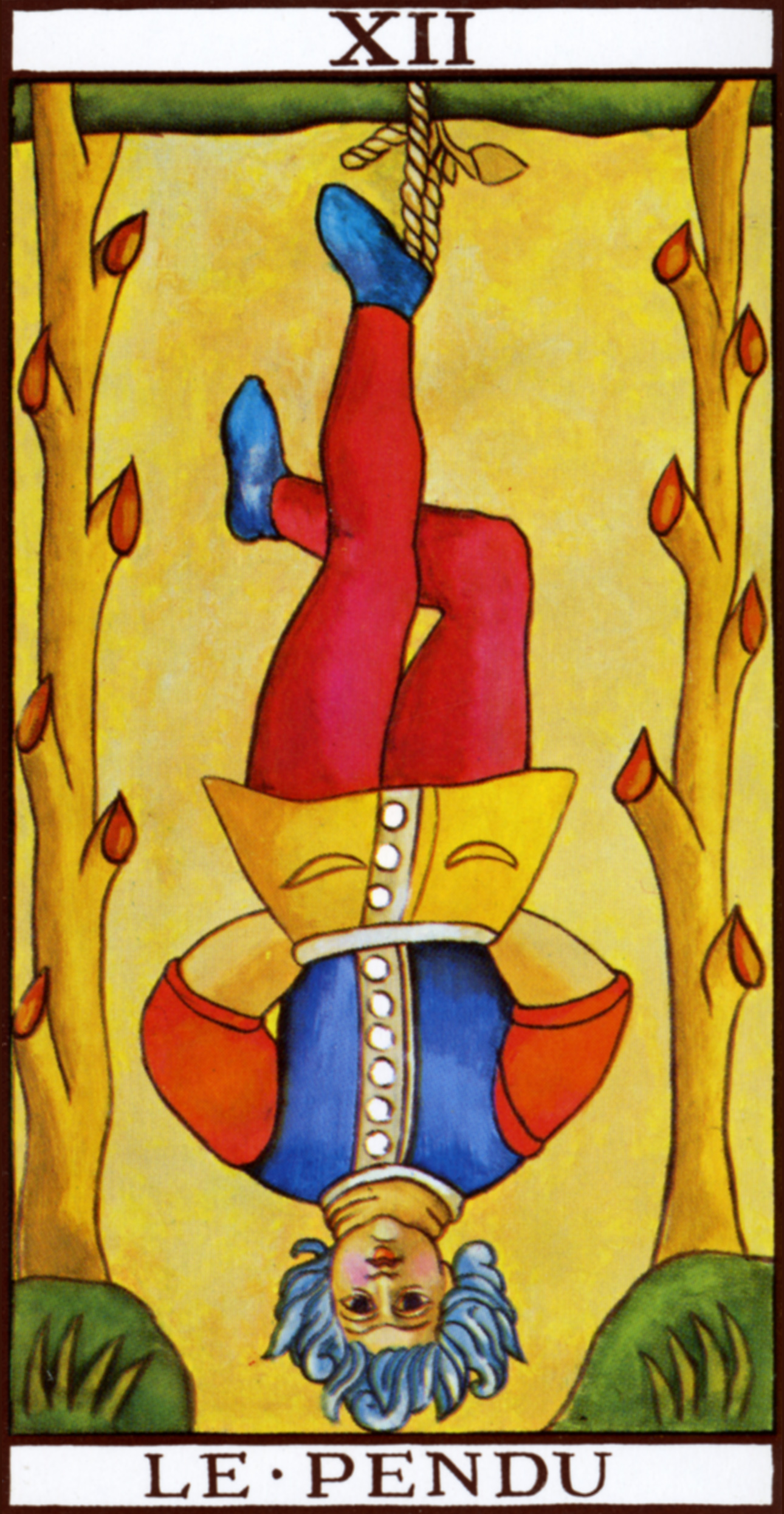
The twelfth card is perhaps among the clearest presentations expressing a number concept in an image. Here two tree trunks appear with six branch stumps each, stuck on either side of a pit. Between the two polarities the unlucky youth is hanged. Again a clear relationship to the sixth card, where the youth stands between opposites, that woo him in feminine form. The indecisiveness has here escalated to a hanging, to inescapable passivity. It is the great ordeal [or trial]. But it doesn’t lead to triumph, to freedom. There remains no other way out of this situation other than death. However, 12 is the number of the Zodiac, of the circumference of the world. 3 and 4 are interwoven within it. But the result is an inflexible wheel that does not turn, a setting that determines nothing, the setting, in fact, of the ordeal, of the great loneliness where everything appears equally separated, wide apart, unreachable. A solitary ordeal in the unfathomable expanse of the world.
13
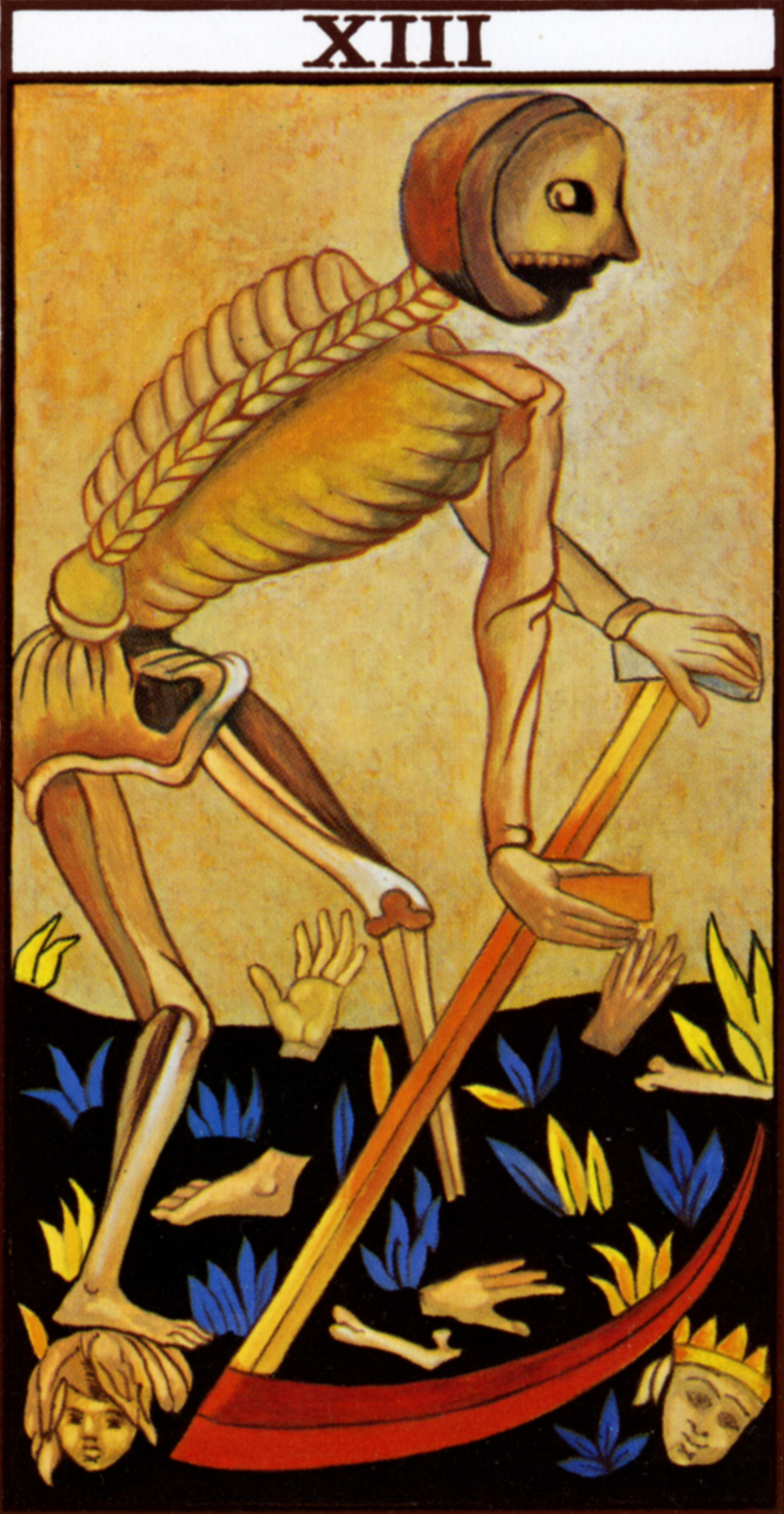
That 13 is supposed to be an unlucky number is understandable from the image of death, which it features. Death is certainly transience, passage of time, the always recurring endpoint. It’s also the sun, which as the 13th element continually passes through the 12 signs of the Zodiac. It can also be thought of as the center of the expanded circle, and therewith the solution and resolution of the cycle of 12. The number 12 can also be formulated as a threefold extension of 4, three intertwined squares that form a circle of maximum tension, and with it, extreme solidity. And the midpoint, crowned with a wreath, the master, which the round dance honors as it twines around it. Here the word applies: death is entwined in victory. Frightening but necessary transition to rebirth, that appears in so many religious systems as a prerequisite to salvation.
14
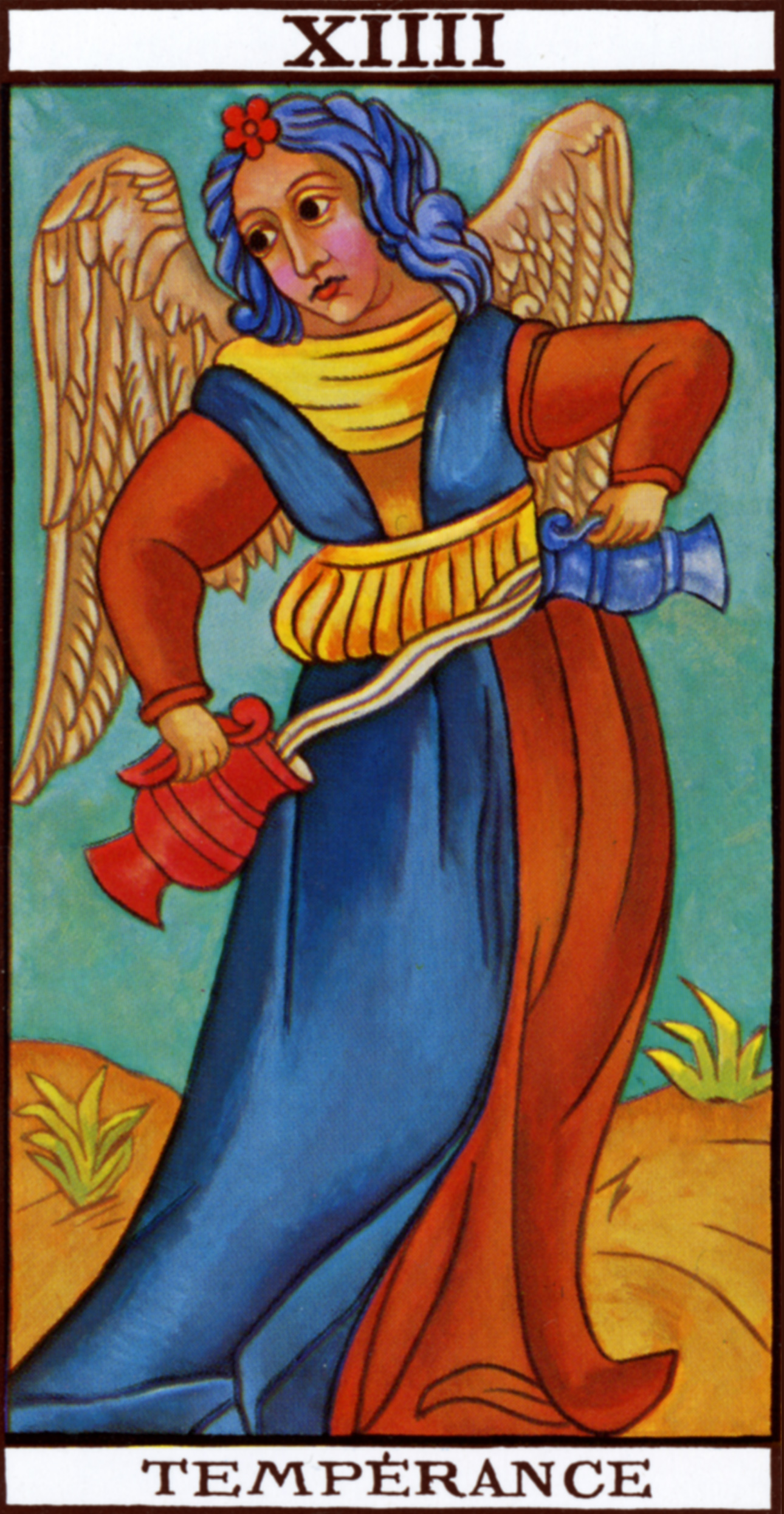
This rebirth is now depicted in the 14th card. A woman pours the contents of a silver pitcher into a gold one. Transformation, recreation. As the consummator of this transfusion from earthly to heavenly existence, the woman may carry the number π. She is 14. And the sum of the digits of the number π [to 4 decimal places]: 3.1415 is 14. Sometimes she is depicted with one foot on a sphere and the other on a cube. So clearly the earthly form of the square is transformed into the heavenly form of a circle. Or also: the bound and doubled 4, so 8 and the similarly doubled 3, the 6. Whereby again the sum of 8 +6 yields 14.
15
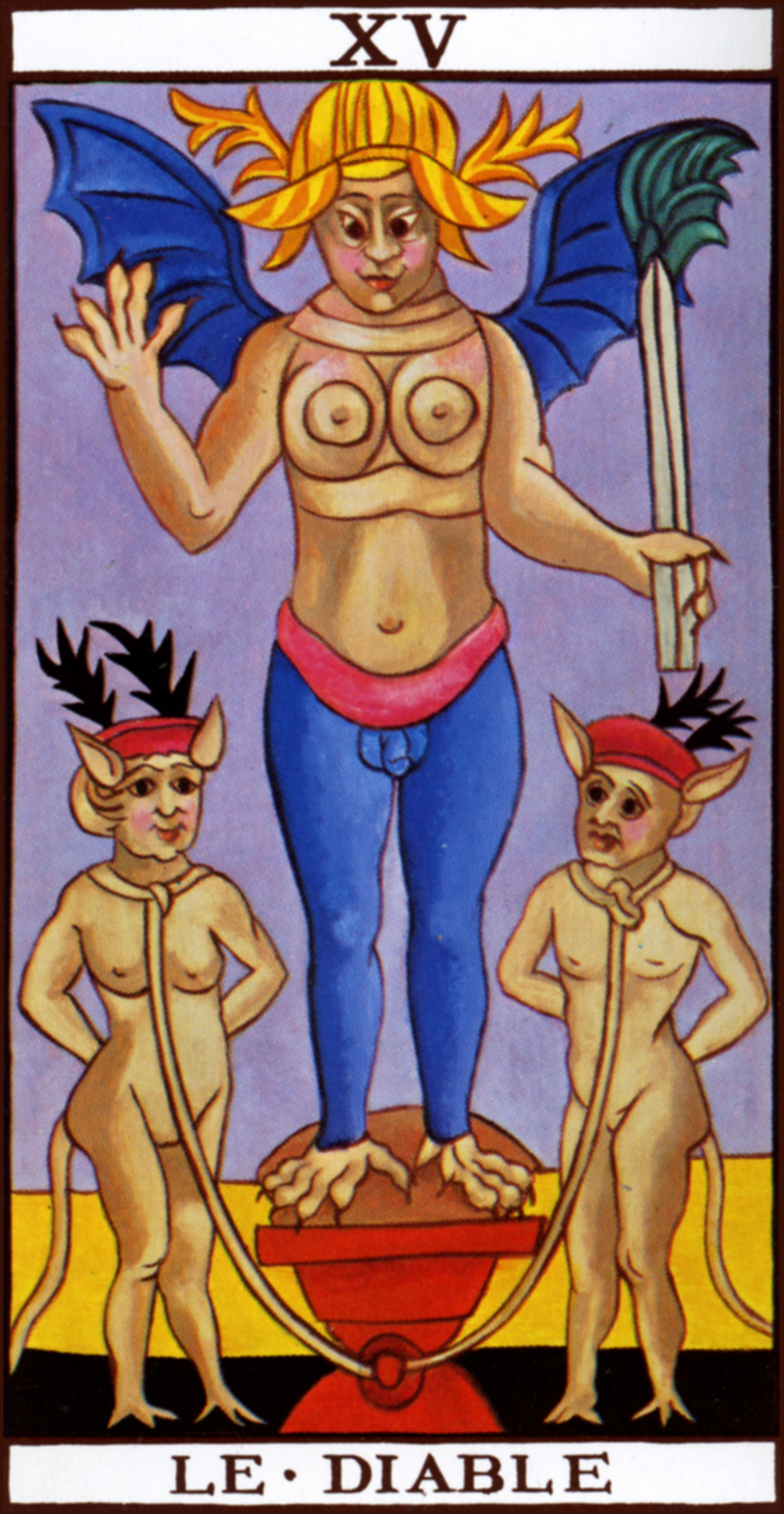
Difficult passage: Three times 5! The triplicate appears either as a holy or a painful number. Here, however, it is pictured as 3 people, consigned to darkness, who present a caricature of the trinity, and at the same time its opposite: a devil-trio. In that connection one may think of a figure that is sometimes portrayed as guardian of the threshold. With that it seems that every weakness and every anxiety is consolidated into this menacing demon, who now blocks the way. We are chained to him, like the smaller devils in the picture [are chained] to the pedestal of the large [one]. The problem is how to make him small. Then the way to the next station is clear.
16
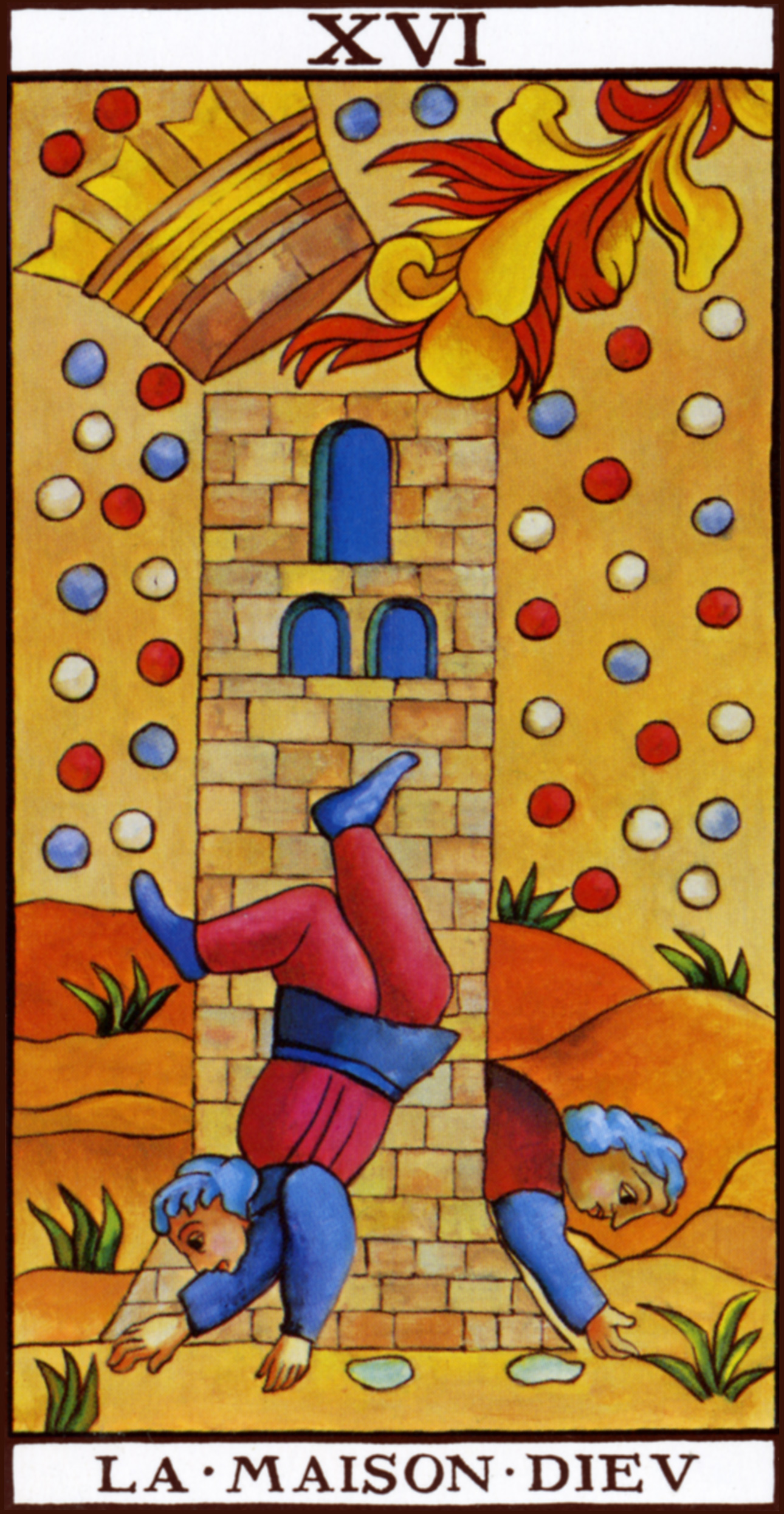
Pure and simple a cuboid is built out of masonry stones. Four squared! Potentiated quality of four, worldliness, pride in this world. All dangers appear to have been overcome. Satisfaction swells in the four-sided construction of building the Tower of Babel. The human imagines himself to have become like God, he believes that he has reached the goal. He names the tower “The House of God.” In contemporary usage that’s the name of a hospital. Originally what was meant is a house erected by a human for his own godliness. Pride counts as the original sin. So it is also the most harshly punished: lightning strikes the tower and smashes its constructor into the abyss. With that everything seems to have come to an end.
17
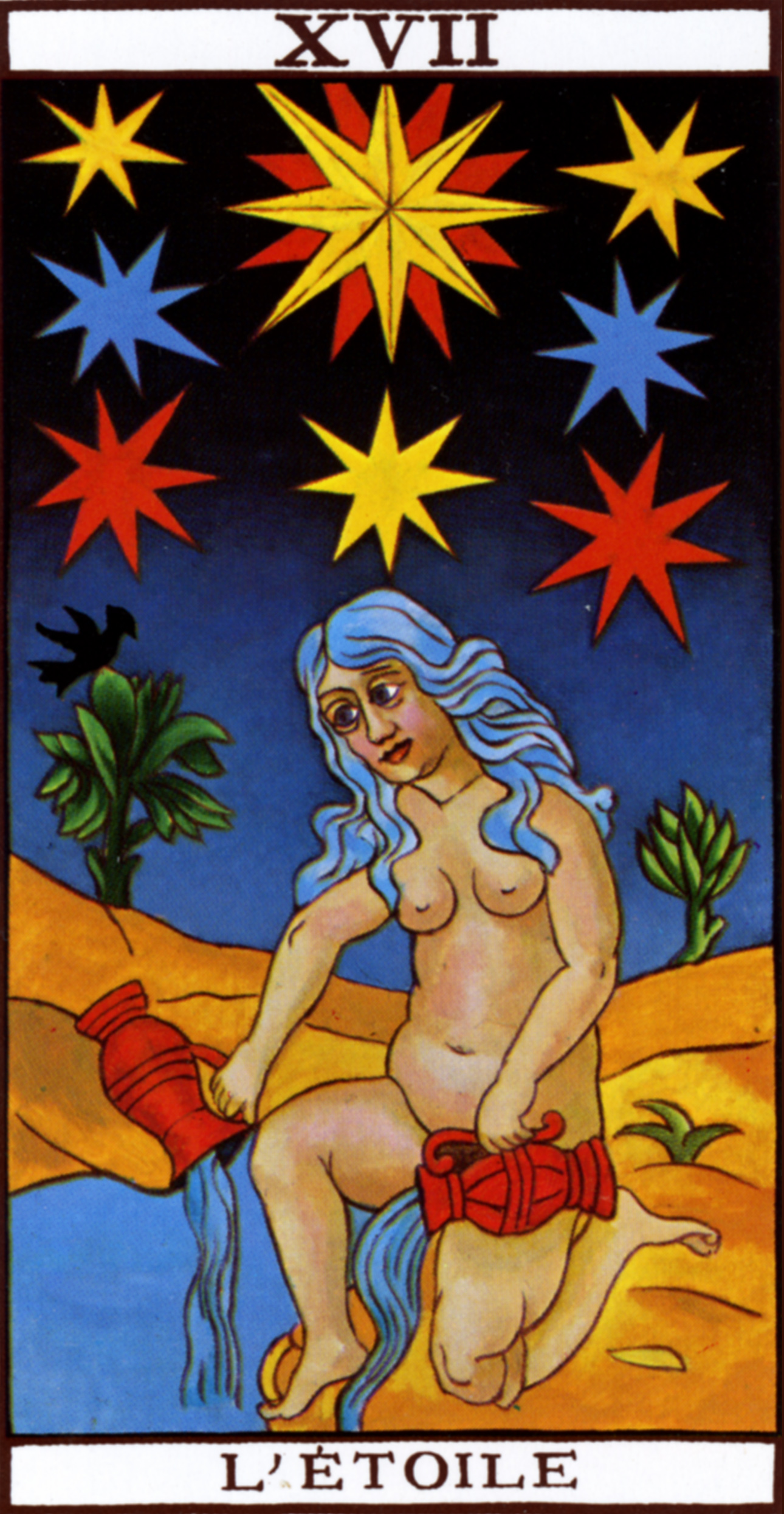
But even this end is only temporary, a transition, a passage. The 17, a prime number that shows hardly any relationship to its neighbors, follows the catastrophe of the 16. The woman performing the action is naked. One may think of a relationship to Venus, all the more so because the image is identified as The Star. Already in Babylon Venus was regarded as the representative of the stars par excellence. Here the naked woman pours from a pitcher that 3 stations earlier was poured into another by her predecessor. Also here we edge toward the end. How are we to read the number 17 in the card? Above there are 8 stars, in the middle a woman on the shore of a sea, on whose surface the 8 stars in the heaven are reflected. Also, there is no recasting in a new form, rather a pouring out of what is above into what is below, whereby what is above and what is below are correlated. The meaning is complex. Should being poured out be damnation or salvation? Indeed both, not as final, but both as new transition.
18
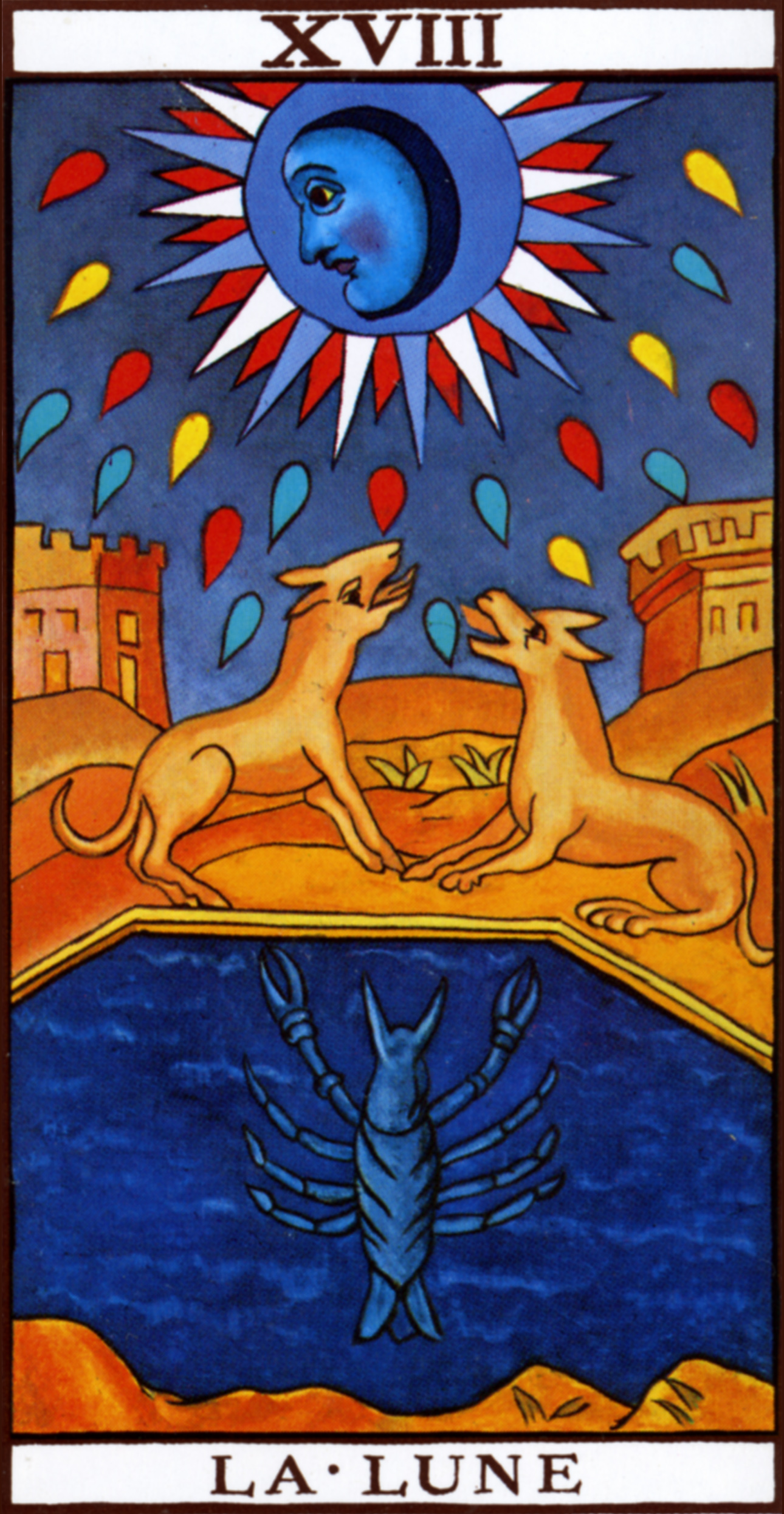
After the 17 puts everything in question, and begs for a new beginning, the 18 again shows a reaching back to [something] earlier. Above we glimpse 2 towers, that we may indeed identify with the number 4. In the foreground a pond appears, in which a 10-legged crab lurks. This animal seems to me to represent the wheel of life of the ten, a Charybdis, while above between the massive towers, Scylla lurks. The 10 below, 2 x 4 above, yields the number of the image, 18. Difficult passage here, as well, between the howling dogs along the winding road. That the crab lurking in the pond is the wheel of changeable destiny is borne out by the moon reflected in the pond, the moon that through its unceasing transformation has become the symbol of the changeable par excellence. The astrological parallel confirms that: the moon is particularly important in the sign of Cancer. Station 18 is therewith marked as a definite forfeiture in the changeable destiny of the world, at least as the danger of such.
19
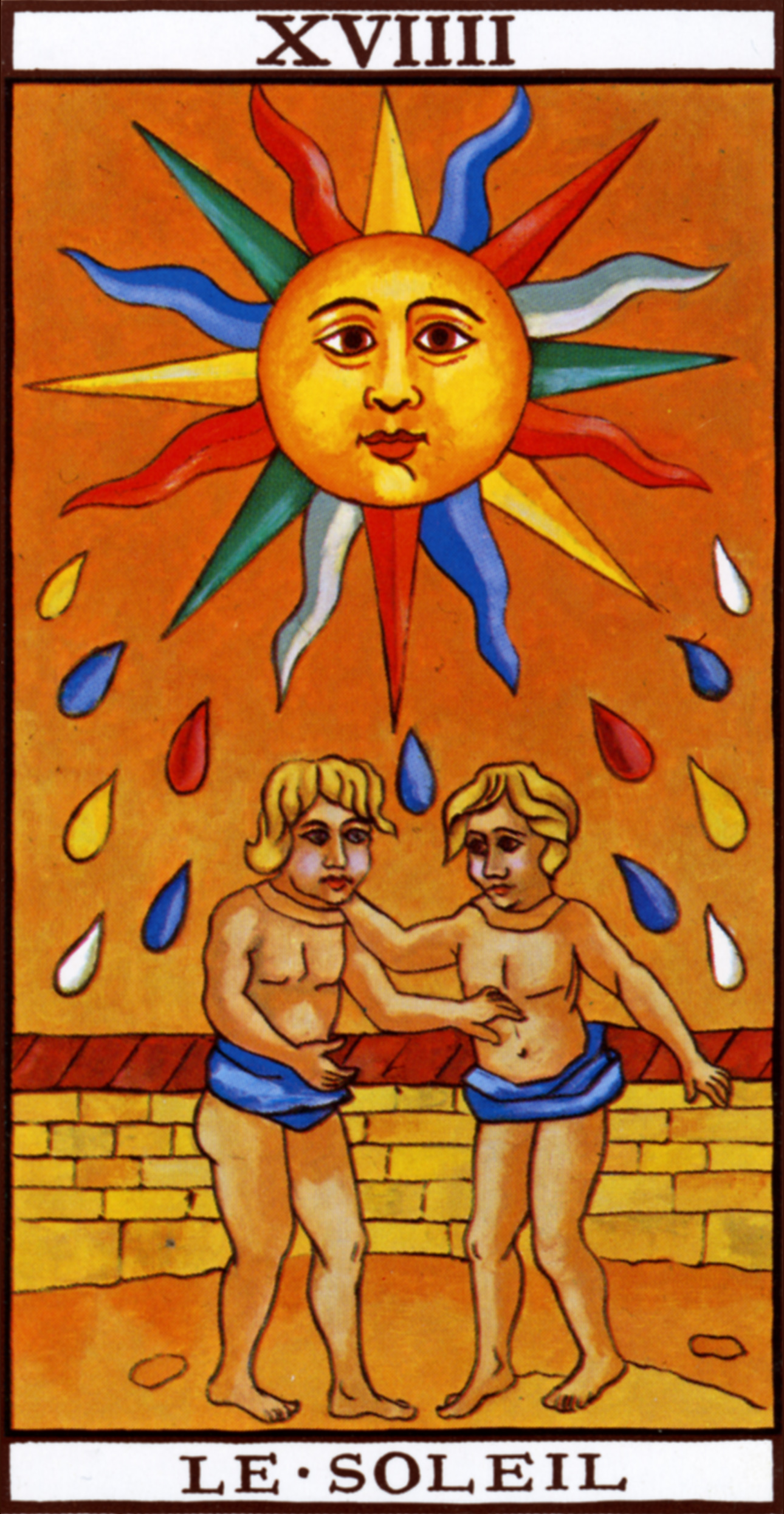
The Sun with 4 glowing and 4 burning beams and its sharply accented center may bring to mind the 9 again. Certainly in the meantime the uncertain flickering light of the Hermit’s lantern has become the victorious brightness of the day star. In front of him are twins, boy and girl, and with that the incarnation of polarity. And because they are young people, they may be presented as a pentagram, that in their polarity point above and below. The number is represented as 9 +5 + 5 = 19. The meaning may be that now the two humans, that indeed represent all of humanity, on this level merge with the consciousness of the universe. For if the image of the 9 means consciousness, here its expansion to universal consciousness is amply emphasized.
20
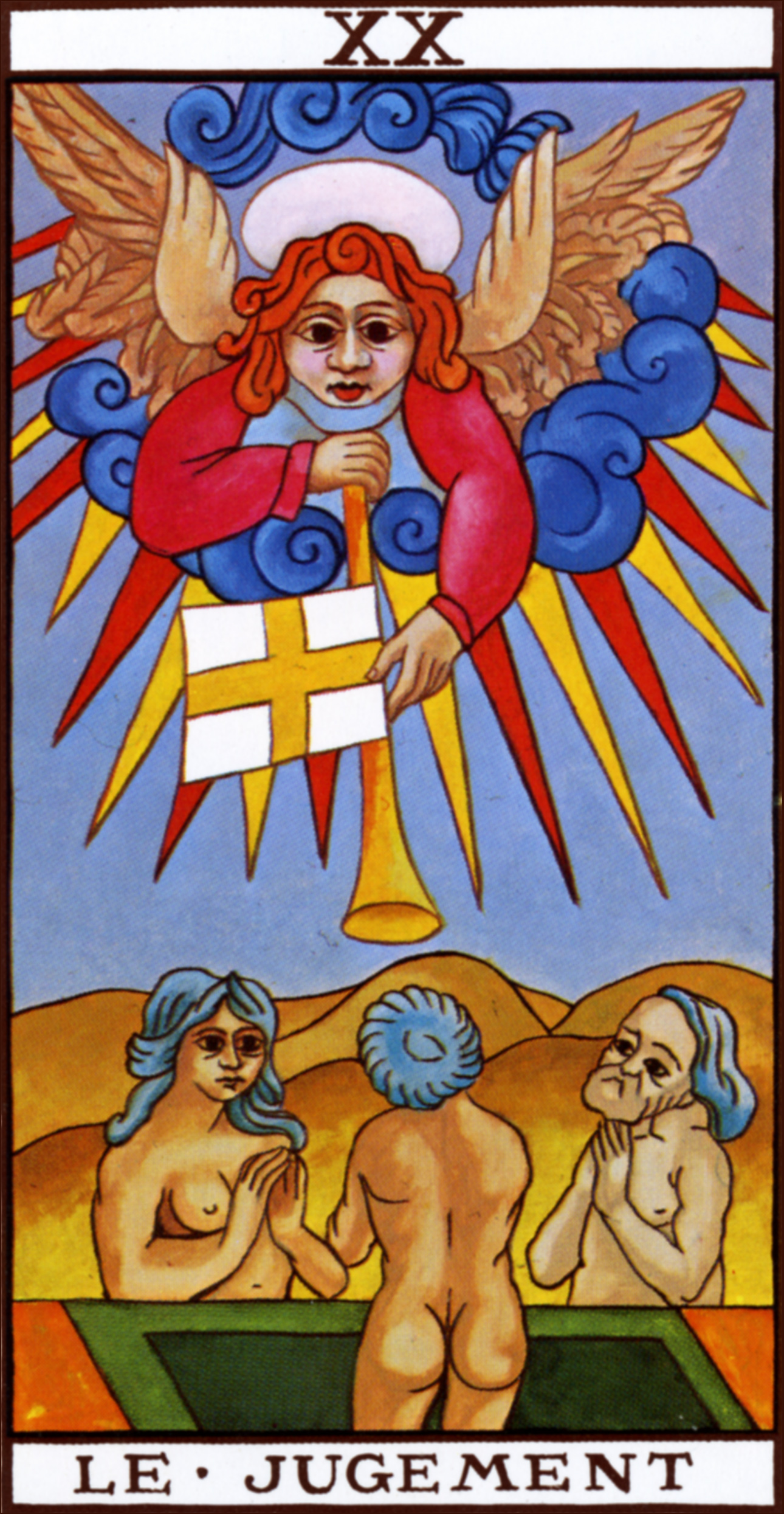
The last separation in the formulation of the final judgment carries the number 20. Above an angel appears with a trumpet that announces the last hour. Glory, which shines down may be presented as two intersecting pentagrams, through which to some extent the situation before the separation, before the decision appears to be indicated. In the moment where now the trumpet sound rings out, the pentagrams are drawn apart. Good tends toward above, bad must go below. The 4 possibilities of the 5 together yield 20. And with that further development is prepared.
21
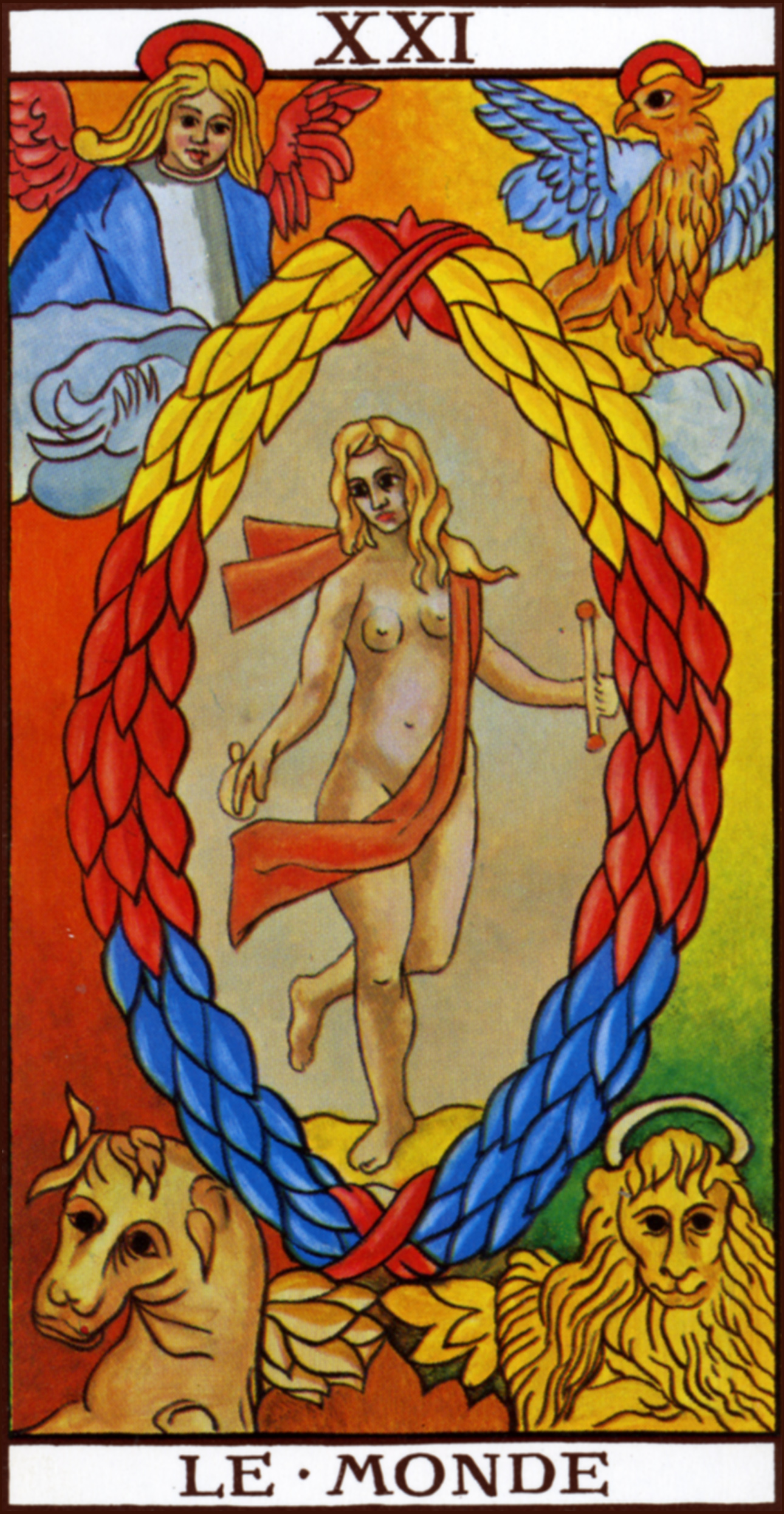
The 21 can be interpreted in various ways. Either the figure in the middle is the perfected human, and the apocalyptic symbolic forms in the corners represent the world-elements that worship him, each with the number 4, so 5 + (4 x 4) = 21. Or we take the 4 forms in the corners to represent 4 humans separated by their unique temperament or character type, and the middle as the middlepoint toward which they strive, so (4 x 5 = ) 20 + 1. Both indicate a final goal of inner development.
0
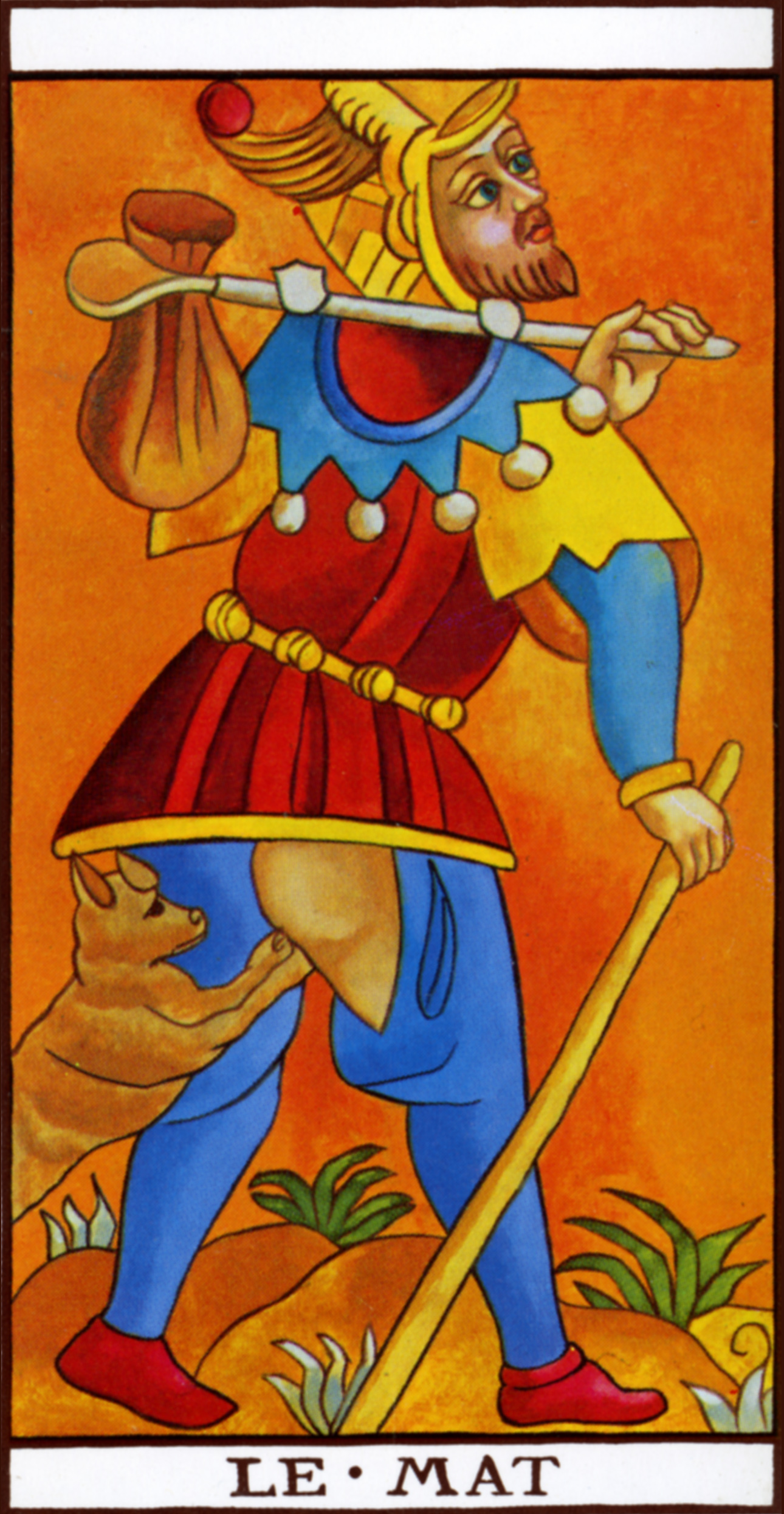
The Fool, the Nothing, the Null, the Circle. And yet, who knows, maybe the beggar’s sack that the Fool carries on his back holds everything that was previously shown and attained. An ambiguous symbol of ultimate knowledge and abundance, and the poorest foolishness. Thus he is the circle, the empty line that returns to itself and at the same time contains the 22 symbols of the Tarot, all together, arranged in the accompanying diagram in the order of the Hebrew alphabet.
There is yet another possibility for depicting the Fool in the geometric image of the Tarot: the numbers 1-21 loop themselves in a tidy circle for the round dance. In the perpetual motion of transformation from one to another they point to progress and evolution. World process. Sparkling cycle of color! The Fool does not participate. He watches the shimmering carousel that turns around him, without taking part. He stands motionless, frozen in the middle, at the hub of the wheel where it is possible to remain at rest amid the turning. He has renounced all the glory of the world. You may brag about imperial crowns and all the treasures of knowledge. He pays no attention. Neither does he feel the foolish animal pulling down his flimsy trousers. He is poor and simple. And yet he wants nothing more. Maybe before this he already tasted too much of the dance of the world process. And now he no longer craves this fare. He has disengaged from turning and transformation. He plunged boldly into the surf, which tore him away from the familiar, from the friendly security of native land and family. He has become homeless, a laughing stock of philosophers and a nagging heartache to those who love him. Then he was alone without help, without counsel. Now he is similarly far away from everything that could attract another. In Tarot that’s called: the hole in the wheel. In another language one would say of him: Having returned home, he’s on the other shore.
1[Translator’s note] This is an apparent reference to the “Bembine Tablet,” now understood to be of likely Roman origin, not Egyptian, possibly connected to a Roman Isis cult. https://en.wikipedia.org/wiki/Bembine_Tablet